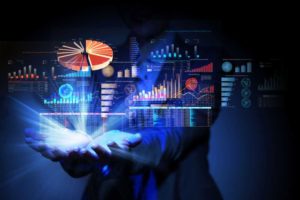Colleges and universities turn to self-service analytics for better results, solving data challenges.
Colleges and universities are home to the most advanced thinking and research in all fields: medicine, law, mathematics, business and beyond. Ironically, such schools haven’t always been as smart when it comes to data. This has been unfortunate, because the data needs of today’s two- and four-year degree granting institutions are as diverse and multidimensional as they come.
Institutional Effectiveness offices need to track trends across the current student population as well as assess future applicants. Institutional researchers and administration rely on timely data to drive decision-making and planning across all functions of the campus, and faculty involved in large research grant programs encounter a whole new set of data requirements. The smorgasbord of data is almost as varied as the course offerings provided to students today. And, the data challenges are further compounded by extraneous factors such as surges in enrollment and global competition.
But many academic institutions are learning new tricks by adopting self-service analytics. The following are four ways higher education is smartening up when it comes to data.
1. Empowering people to work with data
Like other industries and organizations, the traditional way of dealing with data in higher education was fragmented and slow. The IT department—and only the IT department—had access to the data, which was doled out in reports that were slow to come. IT was like an ivory tower within the ivory tower, and the faculty, staff and administrators who needed the data spent most of their time waiting for reports that would be out-of-date on arrival.
This cycle of long waits, static results and general inefficiency is going the way of chalk and blackboards at many schools, like the University of Washington (UW), which has been using UW Profiles since 2012. This project is a set of 23 dashboards that give administrators and faculty more flexible and powerful insight into data, such as performance, retention and support. Now inquisitive UW leaders have a recursive relationship with their data where answering one set of questions leads them down a path of seeking answers to a deeper set of questions.
(Next page: 3 more ways to combat data challenges with self-service analytics)
2. Bringing serious speed to data
Self-service analytics is all about the democratization of data, which inherently creates a faster journey to insight: the people who are experts in the data can start working with their data quickly, with minimal training or IT knowledge. Just like people are used to finding the answer to a question on their phone, laptop or tablet at home, they can get business or academic answers at work.
But, that speed has many dimensions.
For example, the University of Indiana—a huge research university—has been enjoying the fast pace of self-service analytics for years. Enrollment and recruiting officers use dashboards to dive into student data from any angle and depth necessary at high speeds. Trends that used to take weeks or months to identify can now be spotted in hours or minutes.
Another aspect of self-service analytics is the significant reduction in ramp time. Training and adoption are a matter of hours rather than months. Departments that need answers quickly appreciate rapid deployment, and it makes trying new tools less of a risk.
3. Allowing for great flexibility and security
Part of why self-service analytics can be adopted quickly is it enhances rather than replaces an existing data ecosystem. The software works with whatever data is there already. If a college’s data is in SQL, the ERP system, spreadsheets or anything else, it can stay there. Self-service analytics is all about getting more out of the data that already exists.
Though self-service analytics may sound like a free-for-all, data security is actually more important than ever. A strong IT approach will have three components: info should be accurate, available and audited. The accuracy element should be self-evident but often ignored: if data is untrustworthy, it doesn’t really matter how it’s analyzed: the results will be untrustworthy too.
Availability is a complex, multi-tiered issue. The whole idea of self-service analytics is that data is available to everyone who needs it, but that doesn’t mean all data is available to literally everyone. At colleges and universities in particular, security and privacy issues are crucial. So part of IT’s role is figuring out what level of access is appropriate for each department, job and person. Keeping track of who has access to what information is where auditing comes in, and it’s a vitally important job.
At Carnegie-Mellon University, the financial department used self-service analytics to radically update their data analysis while keeping privacy a top priority. This has helped administrators get a handle on up-to-the-minute financial data, wherever they are, on any device. The project was also a test of such methods, which lead to further adoption across the institution.
4. Visualizing the data for easy communication
Just as professors often use visual aids to help students grasp difficult concepts, self-service software creates visualizations that make data easy to understand. Such visualizations are based on research—by, fittingly, experts with advanced academic degrees—on the human visual processing system, to take advantage of our natural strengths and weaknesses.
The University of Texas Austin is constantly growing, as necessitated by its over 52,000 students and 11,000 faculty members. To manage that growth, the university operations team uses self-service analytics to expand the university in the most efficient manner, keeping track of all the elements—human, physical, financial, geographical, etc.—involved in building expansion. This led to a rare trend: steady expansion with shrinking budgets, thanks to the increased efficiency.
The bottom line can be an educational boost too
Colleges and universities are often criticized when they drive their missions through the lens of business objectives but self-service analytics is an example of how the private section is teaching education something valuable. Tools originally designed to drive customer satisfaction and maximize growth are doing the same for higher-learning institutions while fulfilling loftier goals too: higher graduation rates and, ultimately, a better educated society.
- Coalition looks to accelerate LER adoption in higher ed - May 1, 2024
- Selective universities won’t be disrupted - April 30, 2024
- Fully Homomorphic Encryption can revolutionize education - April 29, 2024





